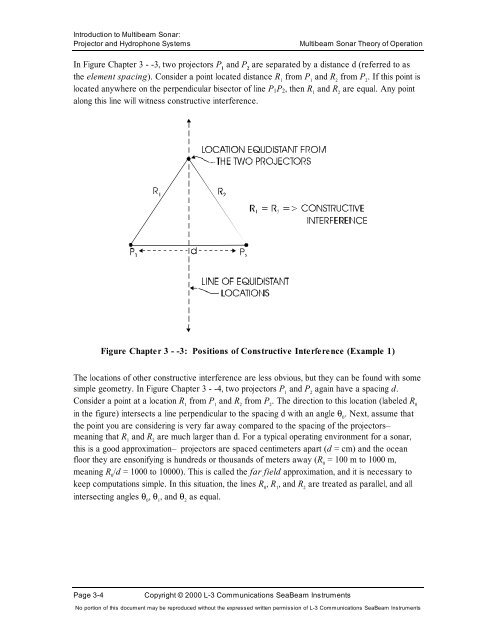Multibeam Sonar Theory of Operation
Multibeam Sonar Theory of Operation
Multibeam Sonar Theory of Operation
Create successful ePaper yourself
Turn your PDF publications into a flip-book with our unique Google optimized e-Paper software.
Introduction to <strong>Multibeam</strong> <strong>Sonar</strong>:<br />
Projector and Hydrophone Systems <strong>Multibeam</strong> <strong>Sonar</strong> <strong>Theory</strong> <strong>of</strong> <strong>Operation</strong><br />
In Figure Chapter 3 - -3, two projectors P 1 and P 2 are separated by a distance d (referred to as<br />
the element spacing). Consider a point located distance R 1 from P 1 and R 2 from P 2 . If this point is<br />
located anywhere on the perpendicular bisector <strong>of</strong> line P1P2, then R 1 and R 2 are equal. Any point<br />
along this line will witness constructive interference.<br />
Figure Chapter 3 - -3: Positions <strong>of</strong> Constructive Interference (Example 1)<br />
The locations <strong>of</strong> other constructive interference are less obvious, but they can be found with some<br />
simple geometry. In Figure Chapter 3 - -4, two projectors P 1 and P 2 again have a spacing d.<br />
Consider a point at a location R 1 from P 1 and R 2 from P 2 . The direction to this location (labeled R 0<br />
in the figure) intersects a line perpendicular to the spacing d with an angle θ 0 . Next, assume that<br />
the point you are considering is very far away compared to the spacing <strong>of</strong> the projectors—<br />
meaning that R 1 and R 2 are much larger than d. For a typical operating environment for a sonar,<br />
this is a good approximation— projectors are spaced centimeters apart (d = cm) and the ocean<br />
floor they are ensonifying is hundreds or thousands <strong>of</strong> meters away (R 0 = 100 m to 1000 m,<br />
meaning R 0 /d = 1000 to 10000). This is called the far field approximation, and it is necessary to<br />
keep computations simple. In this situation, the lines R 0 , R 1 , and R 2 are treated as parallel, and all<br />
intersecting angles θ 0 , θ 1 , and θ 2 as equal.<br />
Page 3-4 Copyright © 2000 L-3 Communications SeaBeam Instruments<br />
No portion <strong>of</strong> this document may be reproduced without the expressed written permission <strong>of</strong> L-3 Communications SeaBeam Instruments
















